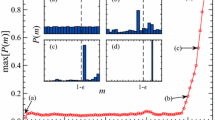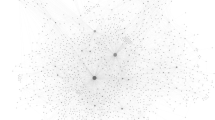Abstract
A new layer of complexity, constituted of networks of information token recurrence, has been identified in socio-technical systems such as the Wikipedia online community and the Zooniverse citizen science platform. The identification of this complexity reveals that our current understanding of the actual structure of those systems, and consequently the structure of the entire World Wide Web, is incomplete, which raises novel questions for data science research but also from the perspective of social epistemology. Here we establish the principled foundations and practical advantages of analyzing information diffusion within and across Web systems with Transcendental Information Cascades, and outline resulting directions for future study in the area of socio-technical systems. We also suggest that Transcendental Information Cascades may be applicable to any kind of time-evolving system that can be observed using digital technologies, and that the structures found in such systems comprise properties common to all naturally occurring complex systems.





Similar content being viewed by others
References
Adamic, L. A., & Huberman, B. A. (2000). Power-law distribution of the world wide web. Science, 287(5461), 2115–2115.
Alvesson, M., & Sandberg, J. (2014). Habitat and habitus: Boxed-in versus box-breaking research. Organization Studies, 35(7), 967–987.
Anick, D., Mitra, D., & Sondhi, M. M. (1982). Stochastic theory of a data-handling system with multiple sources. Bell Labs Technical Journal, 61(8), 1871–1894.
Bailey, K. D. (1990). Social entropy theory. Albany: SUNY Press.
Bailey, K. D. (2006). Living systems theory and social entropy theory. Systems Research and Behavioral Science, 23(3), 291–300.
Barabasi, A.-L. (2005). The origin of bursts and heavy tails in human dynamics. arXiv:cond-mat/0505371.
Barabási, A.-L., Albert, R., & Jeong, H. (2000). Scale-free characteristics of random networks: The topology of the world-wide web. Physica A: Statistical Mechanics and its Applications, 281(1–4), 69–77.
Benbasat, I., Goldstein, D. K., & Mead, M. (1987). The case research strategy in studies of information systems. MIS Quarterly, 11, 369–386.
Berners-Lee, T., Fischetti, M., & Dertouzos, M. L. (2000). Weaving the web: The original design and ultimate destiny of the World Wide Web by its inventor. New York: HarperInformation.
Brin, S., & Page, L. (1998). The anatomy of a large-scale hypertextual web search engine. Computer Networks and ISDN Systems, 30(1–7), 107–117.
Broder, A., Kumar, R., Maghoul, F., Raghavan, P., Rajagopalan, S., Stata, R., et al. (2000). Graph structure in the web. Computer Networks, 33(1), 309–320.
Cebrian, M., Rahwan, I., & Pentland, A. S. (2016). Beyond viral. Communications of the ACM, 59(4), 36–39.
Cheng, J., Adamic, L., Dow, P. A., Kleinberg, J. M., & Leskovec, J. (2014). Can cascades be predicted? In Proceedings of the 23rd international conference on World wide web (pp. 925–936). ACM.
Dinneen, J. D. & Brauner, C. (2017). Information-not-thing: further problems with and alternatives to the belief that information is physical. In CAIS-ACSI ‘17: Proceedings of the 2017 Canadian Association for Information Science.
Dinneen, J. D., & Brauner, C. (2015). Practical and philosophical considerations for defining information as well-formed, meaningful data in the information sciences. Library Trends, 63(3), 378–400.
Donner, R. V., Small, M., Donges, J. F., Marwan, N., Zou, Y., Xiang, R., et al. (2011). Recurrence-based time series analysis by means of complex network methods. International Journal of Bifurcation and Chaos, 21(04), 1019–1046.
Eckmann, J.-P., Kamphorst, S. O., & Ruelle, D. (1987). Recurrence plots of dynamical systems. EPL (Europhysics Letters), 4(9), 973.
Eisenhardt, K. M. (1989). Building theories from case study research. Academy of Management Review, 14(4), 532–550.
Feld, S. L. (1991). Why your friends have more friends than you do. American Journal of Sociology, 96(6), 1464–1477.
Floridi, L. (2015). Semantic conceptions of information. Stanford: The Metaphysics Research Lab, Stanford University.
Grudin, J. (1994). Computer-supported cooperative work: History and focus. Computer, 27(5), 19–26.
Hendler, J., & Berners-Lee, T. (2010). From the semantic web to social machines: A research challenge for ai on the world wide web. Artificial Intelligence, 174(2), 156–161.
Hohenberg, P. C., & Halperin, B. I. (1977). Theory of dynamic critical phenomena. Reviews of Modern Physics, 49(3), 435.
Holme, P., & Saramäki, J. (2012). Temporal networks. Physics Reports, 519(3), 97–125.
Honari, A. (2015). Online social research in Iran: A need to offer a bigger picture. CyberOrient: The Online Journal of Virtual Middle East, 9(2).
Jung, C. G. (2010). Synchronicity: An acausal connecting principle. (From Vol. 8. of the collected works of CG Jung) (New in Paper). Princeton: Princeton University Press.
Kant, I. (1934). Critique of pure reason. (Trans: Smith, N. K.). London: Macmillan.
Keegan, B. C., Lev, S., & Arazy, O. (2016). Analyzing organizational routines in online knowledge collaborations: A case for sequence analysis in CSCW. In Proceedings of the 19th ACM conference on computer-supported cooperative work & social computing (pp. 1065–1079). ACM.
Kleinberg, J. (2003). Bursty and hierarchical structure in streams. Data Mining and Knowledge Discovery, 7(4), 373–397.
Kraut, R. E., Resnick, P., Kiesler, S., Burke, M., Chen, Y., Kittur, N., et al. (2012). Building successful online communities: Evidence-based social design. Cambridge: MIT Press.
Kullback, S. (1997). Information theory and statistics. Chelmsford: Courier Corporation.
Lee, C. P. & Paine, D. (2015). From the matrix to a model of coordinated action (moca): A conceptual framework of and for CSCW. In Proceedings of the 18th ACM conference on computer supported cooperative work & social computing (pp. 179–194). ACM.
Lee, E., Karimi, F., Jo, H.-H., Strohmaier, M., & Wagner, C. (2017). Homophily explains perception biases in social networks. arXiv:1710.08601.
Lee, A. S. (2010). Retrospect and prospect: Information systems research in the last and next 25 years. Journal of Information Technology, 25(4), 336–348.
Lerman, K. (2016). Information is not a virus, and other consequences of human cognitive limits. Future Internet, 8(2), 21.
Lerman, K., Yan, X., & Wu, X.-Z. (2016). The “majority illusion” in social networks. PloS ONE, 11(2), e0147617.
Luczak-Roesch, M., Tinati, R., & Shadbolt, N. (2015b). When resources collide: Towards a theory of coincidence in information spaces. In Proceedings of the 24th international conference on world wide web (pp. 1137–1142). ACM.
Luczak-Roesch, M., Tinati, R., O’Hara, K., & Shadbolt, N. (2015a). Socio-technical computation. In Proceedings of the 18th ACM conference companion on computer supported cooperative work & social computing (pp. 139–142). ACM.
Luczak-Roesch, M., Tinati, R., Simperl, E., Van Kleek, M., Shadbolt, N., & Simpson, R. J. (2014). Why won’t aliens talk to us? content and community dynamics in online citizen science. In ICWSM.
Luczak-Roesch, M., Tinati, R., Van Kleek, M., & Shadbolt, N. (2015c). From coincidence to purposeful flow? properties of transcendental information cascades. In Proceedings of the 2015 IEEE/ACM international conference on advances in social networks analysis and mining 2015 (pp. 633–638). ACM.
Malone, T. W., Laubacher, R., & Dellarocas, C. (2009). Harnessing crowds: Mapping the genome of collective intelligence. Technical Report No. 4732-09, MIT Sloan Research Paper.
McKinney, E. H, Jr., & Yoos, C. J. (2010). Information about information: A taxonomy of views. MIS Quarterly, 34, 329–344.
McLuhan, M., & Fiore, Q. (1967). The medium is the message. New York, 123, 126–128.
Ovchinnikov, I. V. (2016). Introduction to supersymmetric theory of stochastics. Entropy, 18(4), 108.
Parameswaran, M., & Whinston, A. B. (2007). Research issues in social computing. Journal of the Association for Information Systems, 8(6), 336.
Parisi, G., & Sourlas, N. (1982). Supersymmetric field theories and stochastic differential equations. Nuclear Physics B, 206(2), 321–332.
Pettit, P. (2006). When to defer to majority testimony-and when not. Analysis, 66(291), 179–187.
Pettit, P. (2010). Groups with minds of their own. In A. I. Goldman & D. Whitcomb (Eds.), Social epistemology: Essential readings (p. 242). Oxford: Oxford University Press.
Popper, K. (1972). Objective knowledge: An evolutionary approach. Oxford University Press.
Popper, K. (2013). Knowledge and the body-mind problem: In defence of interaction. London: Routledge.
Potthast, M., Stein, B., & Gerling, R. (2008). Automatic vandalism detection in wikipedia. In European conference on information retrieval (pp. 663–668). Springer.
Quinn, A. J. & Bederson, B. B. (2011). Human computation: A survey and taxonomy of a growing field. In Proceedings of the SIGCHI conference on human factors in computing systems (pp. 1403–1412). ACM.
Rabiner, L. R. (1989). A tutorial on hidden markov models and selected applications in speech recognition. Proceedings of the IEEE, 77(2), 257–286.
Shahaf, D., Yang, J., Suen, C., Jacobs, J., Wang, H., & Leskovec, J. (2013). Information cartography: Creating zoomable, large-scale maps of information. In Proceedings of the 19th ACM SIGKDD international conference on Knowledge discovery and data mining (pp. 1097–1105). ACM.
Shannon, C. E. (1949). Communication theory of secrecy systems. Bell Labs Technical Journal, 28(4), 656–715.
Smart, P. R. (2018). Mandevillian intelligence. Synthese, 195(9), 4169–4200. https://doi.org/10.1007/s11229-017-1414-z.
Smart, P., Simperl, E., & Shadbolt, N. (2014). A taxonomic framework for social machines. In D. Miorandi, V. Maltese, M. Rovatsos, A. Nijholt, & J. Stewart (Eds.), Social collective intelligence (pp. 51–85). Cham: Springer.
Strogatz, S. H. (2014). Nonlinear dynamics and chaos: With applications to physics, biology, chemistry, and engineering. London: Hachette UK.
Tarski, A. (1944). The semantic conception of truth: And the foundations of semantics. Philosophy and Phenomenological Research, 4(3), 341–376.
Tinati, R., & Luczak-Roesch, M. (2017). Wikipedia: A complex social machine. SIGWEB Newsletter, Winter, 6. https://doi.org/10.1145/3027141.3027147.
Tinati, R., Luczak-Roesch, M., & Hall, W. (2016). Finding structure in wikipedia edit activity: An information cascade approach. In Proceedings of the 25th international conference companion on world wide web (pp. 1007–1012). International World Wide Web Conferences Steering Committee.
Tinati, R., Luczak-Roesch, M., Shadbolt, N., & Hall, W. (2015a). Using wikiprojects to measure the health of wikipedia. In Proceedings of the 24th international conference on world wide web (pp. 369–370). ACM.
Tinati, R., Van Kleek, M., Simperl, E., Luczak-Rösch, M., Simpson, R., & Shadbolt, N. (2015b). Designing for citizen data analysis: A cross-sectional case study of a multi-domain citizen science platform. In Proceedings of the 33rd Annual ACM Conference on Human Factors in Computing Systems (pp. 4069–4078). ACM.
Van de Sompel, H., Nelson, M., & Sanderson, R. (2013). HTTP framework for time-based access to resource states–Memento. No. RFC 7089. https://www.rfc-editor.org/info/rfc7089.
Van de Sompel, H., Nelson, M. L., Sanderson, R., Balakireva, L. L., Ainsworth, S., & Shankar, H. (2009). Memento: Time travel for the web. arXiv:0911.1112.
Webber Jr, C. L. & Zbilut, J. P. (2005). Recurrence quantification analysis of nonlinear dynamical systems. In Tutorials in contemporary nonlinear methods for the behavioral sciences (pp. 26–94). National Science Foundation.
Weber, M. (1978). Economy and society: An outline of interpretive sociology (Vol. 1). Berkeley: University of California Press.
Whitehead, A . N., & Russell, B. (1912). Principia mathematica (Vol. 2). Cambridge: University Press.
Williams, M. J., & Musolesi, M. (2016). Spatio-temporal networks: Reachability, centrality and robustness. Royal Society Open Science, 3(6), 160196.
Woolley, A. W., Chabris, C. F., Pentland, A., Hashmi, N., & Malone, T. W. (2010). Evidence for a collective intelligence factor in the performance of human groups. Science, 330(6004), 686–688.
Zollman, K. J. (2007). The communication structure of epistemic communities. Philosophy of Science, 74(5), 574–587.
Acknowledgements
This article underwent an extensive open peer-review process, because the initial version was published as a pre-print on PeerJ (https://doi.org/10.7287/peerj.preprints.2789). The authors want thank all people who took the time to provide critical comments and feedback about this version or who engaged in discussions when the argument was presented at scientific events. Our work was partially supported under SOCIAM: The Theory and Practice of Social Machines, funded by the UK EPSRC under Grant EP/J017728/2 and the Victoria University of Wellington Research Establishment Grant 8-1620-213486-3744.
Author information
Authors and Affiliations
Corresponding author
Rights and permissions
About this article
Cite this article
Luczak-Roesch, M., O’Hara, K., Dinneen, J.D. et al. What an Entangled Web We Weave: An Information-centric Approach to Time-evolving Socio-technical Systems. Minds & Machines 28, 709–733 (2018). https://doi.org/10.1007/s11023-018-9478-1
Received:
Accepted:
Published:
Issue Date:
DOI: https://doi.org/10.1007/s11023-018-9478-1




